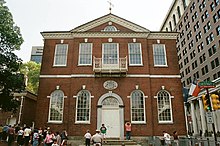5th United States Congress
| 5th United States Congress | |
|---|---|
|
4th ←
→ 6th
|
|

Congress Hall (2007)
|
|
| March 4, 1797 – March 4, 1799 | |
| Senate President | Thomas Jefferson (DR) |
| Senate Pres. pro tem |
William Bradford (F) Jacob Read (F) Theodore Sedgwick (F) John Laurance (F) James Ross (F) |
| House Speaker | Jonathan Dayton (F) |
| Members | 32 Senators 106 Representatives |
| Senate Majority | Federalist |
| House Majority | Federalist |
| Sessions | |
|
Special: March 4, 1797 – March 4, 1797 1st: May 15, 1797 – July 10, 1797 2nd: November 13, 1797 – July 16, 1798 Special: July 17, 1798 – July 19, 1798 3rd: December 3, 1798 – March 3, 1799 |
|
The Fifth United States Congress was a meeting of the legislative branch of the United States federal government, consisting of the United States Senate and the United States House of Representatives. It met at Congress Hall in Philadelphia, Pennsylvania from March 4, 1797 to March 4, 1799, during the first two years of John Adams's presidency.
The apportionment of seats in this House of Representatives was based on the First Census of the United States in 1790. Both chambers had a Federalist majority.
Details on changes are shown below in the "Changes in membership" section.
This list is arranged by chamber, then by state. Senators are listed in order of seniority, and Representatives are listed by district.
Senators were elected by the state legislatures every two years, with one-third beginning new six-year terms with each Congress. Preceding the names in the list below are Senate class numbers, which indicate the cycle of their election. In this Congress, Class 1 meant their term began in this Congress, requiring reelection in 1802; Class 2 meant their term ended with this Congress, requiring reelection in 1798; and Class 3 meant their term began in the last Congress, requiring reelection in 1800.
All representatives were elected statewide on a general ticket.
(7 Federalists)
(1 Federalist)
Both representatives were elected statewide on a general ticket.
(2 Democratic-Republicans)
(2 Democratic-Republicans)
(6-1 Democratic-Republican)
(11-2 Democratic-Republican)
All representatives were elected statewide on a general ticket.
(4 Federalists)
All representatives were elected statewide on a general ticket.
(5 Federalists)
...
Wikipedia
